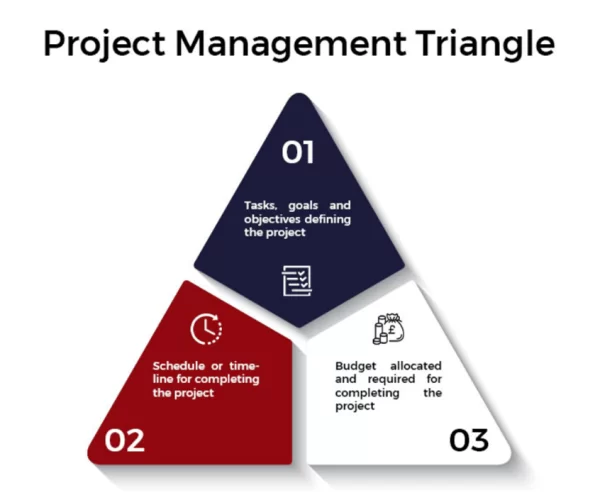
OTHM Level 7 Diploma in Strategic Management and Leadership (RQF)
£990 £690 Limited Time Offer Monthly instalment plans are available. Awarding body fee of £300 is payable by the learner to the awarding organisation within
The project management triangle, referred to as the iron triangle, gold triangle or triple constraint (cost, scope and time), is used by managers around the world to achieve the best results at the end of their project. By successfully maintaining these three constraints – time, scope and budget – managers may get to enjoy many benefits like fewer project risks, streamlined client communication and adaptability to management changes.
The three constraints – time, scope and budget – help project managers greatly in managing projects like change in the project, clear communication with stakeholders, and fewer risks in the projects. For instance, when faced with a scope change and a tight deadline, managers can add talent to speed up progress instead of altering the scope. In doing so, managers will have the opportunity to gather new ideas and valuable insights to navigate project changes effectively and efficiently.
Other than that, the project management triangle also helps in prioritising project tasks. For example, if additional budget is required to complete the project, through the project management triangle, project managers will know how to keep a close eye on the scope and time, knowing that if the scope increases, either the budget, time or both will automatically increase. Regardless of these benefits, each component of the project management’s triangle carries distinct significance which is mentioned below:
A project management triangle has 3 components depicting the three sides of the triangle: cost, scope and time. All three components must be balanced to produce a quality end product. If one side is imbalanced, the triangle may be too long or short.
The overview of each component is mentioned below:
1. Scope

If you are an aspiring entrepreneur and a business leader, a business management course is ideal. It will help you become a valuable asset to any organisation as you will be equipped with the right skills like problem-solving, critical and strategic thinking and project management required to respond to challenges faced in the development of business. Besides gaining several career opportunities, you will have the core skills after completing the Level 5 Diploma in Business Management to start your own business as well as effectively shape the direction of your career.
2. Time
Here is how one can balance the time of the project:
3. Cost
Regardless of the project type, one needs cost to commence and complete the project; however, cost does not mean thousands of pounds. The cost can often be referred to as the resources. These resources may come as manpower, tools, equipment, raw materials and other facilities.
Here is how one can balance the cost of the project:
Among the triple constraints of project management, there are two relationships at play. First, the scope is directly proportional to time and cost; the scope moves in the same direction as the other two, meaning if the scope of the project increases, the other two constraints – time and cost – will naturally increase to tackle the project efficiently.
The second relationship is between, cost and time which are inversely proportional to each other and, hence moves in opposite direction. Considering this, suppose the budget of the project is reduced, meaning the project’s completion time will be extended. On the other hand, if a project has a tight deadline, one will need an extra budget to balance the three constraints.
This is why sometimes the project management triangle is called the iron triangle; regardless of the project at hand, no manager can bend the triangle according to their will. However, one thing is for sure, through the triangle of project management, you and your team can hit the ground running with this triangle of quality and no matter how hard the project each deadline and milestone can be achieved efficiently and timely.
Regardless of where you are in your career, you can acquire a deep understanding and extensive knowledge of the project management triangle by enrolling in a project management course. At Britannia School of Leadership and Management, we provide the Level 7 Diploma in Project Management, offering an opportunity to gain essential skills and knowledge. So, start your journey with our project management course today and elevate your career in your respective field.
The project management triangle is highly crucial for any project as it keeps the whole project in check and the whole team’s eye on important and key variables that may or may not compromise the quality of the project. Managing these constraints can be challenging; however, with proper planning, and strategy, quality outcomes can be accomplished.

£990 £690 Limited Time Offer Monthly instalment plans are available. Awarding body fee of £300 is payable by the learner to the awarding organisation within